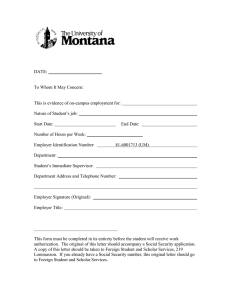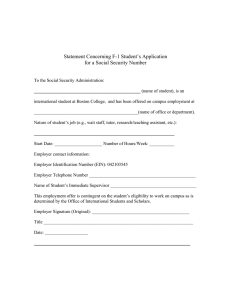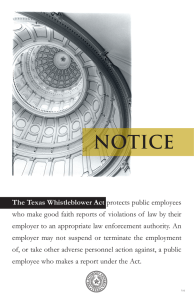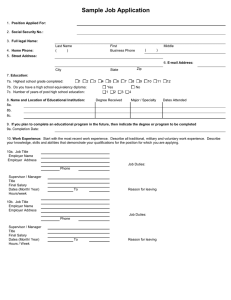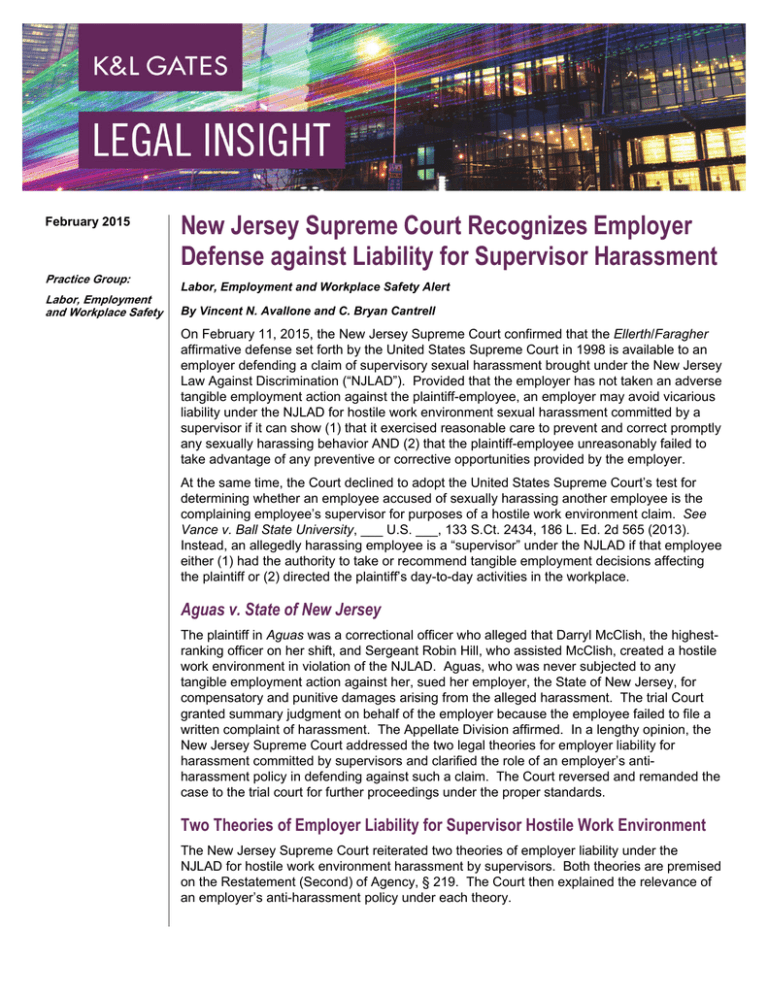
February 2015
Practice Group:
Labor, Employment
and Workplace Safety
New Jersey Supreme Court Recognizes Employer
Defense against Liability for Supervisor Harassment
Labor, Employment and Workplace Safety Alert
By Vincent N. Avallone and C. Bryan Cantrell
On February 11, 2015, the New Jersey Supreme Court confirmed that the Ellerth/Faragher
affirmative defense set forth by the United States Supreme Court in 1998 is available to an
employer defending a claim of supervisory sexual harassment brought under the New Jersey
Law Against Discrimination (“NJLAD”). Provided that the employer has not taken an adverse
tangible employment action against the plaintiff-employee, an employer may avoid vicarious
liability under the NJLAD for hostile work environment sexual harassment committed by a
supervisor if it can show (1) that it exercised reasonable care to prevent and correct promptly
any sexually harassing behavior AND (2) that the plaintiff-employee unreasonably failed to
take advantage of any preventive or corrective opportunities provided by the employer.
At the same time, the Court declined to adopt the United States Supreme Court’s test for
determining whether an employee accused of sexually harassing another employee is the
complaining employee’s supervisor for purposes of a hostile work environment claim. See
Vance v. Ball State University, ___ U.S. ___, 133 S.Ct. 2434, 186 L. Ed. 2d 565 (2013).
Instead, an allegedly harassing employee is a “supervisor” under the NJLAD if that employee
either (1) had the authority to take or recommend tangible employment decisions affecting
the plaintiff or (2) directed the plaintiff’s day-to-day activities in the workplace.
Aguas v. State of New Jersey
The plaintiff in Aguas was a correctional officer who alleged that Darryl McClish, the highestranking officer on her shift, and Sergeant Robin Hill, who assisted McClish, created a hostile
work environment in violation of the NJLAD. Aguas, who was never subjected to any
tangible employment action against her, sued her employer, the State of New Jersey, for
compensatory and punitive damages arising from the alleged harassment. The trial Court
granted summary judgment on behalf of the employer because the employee failed to file a
written complaint of harassment. The Appellate Division affirmed. In a lengthy opinion, the
New Jersey Supreme Court addressed the two legal theories for employer liability for
harassment committed by supervisors and clarified the role of an employer’s antiharassment policy in defending against such a claim. The Court reversed and remanded the
case to the trial court for further proceedings under the proper standards.
Two Theories of Employer Liability for Supervisor Hostile Work Environment
The New Jersey Supreme Court reiterated two theories of employer liability under the
NJLAD for hostile work environment harassment by supervisors. Both theories are premised
on the Restatement (Second) of Agency, § 219. The Court then explained the relevance of
an employer’s anti-harassment policy under each theory.
New Jersey Supreme Court Recognizes Employer Defense against Liability for
Supervisor Harassment
Under the first theory, an employee can assert a direct cause of action against the employer
for negligence or recklessness causing the hostile work environment. To prevail, a plaintiff
must show that the employer failed to exercise due care with respect to sexual harassment
in the workplace, that its breach of the duty of due care caused the plaintiff’s harm, and that
she sustained damages. In a prior opinion, Gaines v. Bellino, 173 N.J. 301 (2002), the Court
recognized five factors relevant to a hostile work environment claim against an employer
under the negligence theory: (1) formal policies prohibiting harassment; (2) formal and
informal complaint structures available to employees; (3) anti-harassment training, which
must be mandatory for supervisors and managers and available to all other employees; (4)
existence of effective sensing or monitoring mechanisms to check the trustworthiness of the
policies and complaint structures; and (5) an unequivocal commitment from the highest
levels of the employer that harassment would not be tolerated, and demonstration of that
commitment through consistent practice. As such, the existence of an anti-harassment
policy is evidence weighing against employer liability. However, existence of an antiharassment policy alone it is not sufficient to avoid liability, nor is an employer liable per se if
it lacks an anti-harassment policy.
The second theory for employer liability is that an employer is vicariously liable for the
actions of its supervisor, who is its agent. To establish vicarious liability, a plaintiff must
show (1) the employer delegated authority to the supervisor to control the situation about
which the plaintiff complains, (2) the supervisor exercised that authority, (3) the supervisor’s
exercise of that authority resulted in a violation of the NJLAD, and (4) the authority delegated
by the employer to the supervisor aided the supervisor in injuring the plaintiff. It was under
this theory that the Court confirmed the availability of the affirmative defense previously
recognized by the U.S. Supreme Court in Burlington Industries v. Ellerth, 524 U.S. 742
(1998), and Faragher v. City of Boca Raton, 524 U.S. 775 (1998). Under the
Faragher/Ellerth cases, an employer has an affirmative defense against vicarious liability if it
can prove (1) that it exercised reasonable care to prevent and correct promptly any sexually
harassing behavior AND (2) that the plaintiff-employee unreasonably failed to take
advantage of any preventive or corrective opportunities provided by the employer or to avoid
harm otherwise.
U.S. Supreme Court’s Definition of Supervisor Rejected
The New Jersey Supreme Court also clarified who would qualify as a “supervisor” for
purposes of establishing employer liability for supervisory sexual harassment. The U.S.
Supreme Court recently held that, under Title VII, a “supervisor” is an employee who is
“granted the authority to make tangible employment decisions,” but rejected the Equal
Employment Opportunity Commission’s inclusion of employees who are “placed in charge of
the complainant’s daily work activities” as “supervisors.” The New Jersey Supreme Court
declined to adopt the U.S. Supreme Court’s reasoning and, instead, adopted the broader
approach of the EEOC, and held that supervisors included both types of employees for
purposes of analyzing supervisory sexual harassment claims under the NJLAD.
2
New Jersey Supreme Court Recognizes Employer Defense against Liability for
Supervisor Harassment
Implications for Employers
The Court’s decision in Aguas serves as a useful reminder of the importance for New Jersey
employers to implement and enforce comprehensive and effective policies prohibiting
discrimination, including hostile work environment sexual harassment. The Aguas decision
confirms that an employer can overcome vicarious liability with effective anti-harassment
policies, and such practices also weigh against employer liability under a negligence theory.
At the same time, Aguas reminds employers that the NJLAD may not be construed in the
same manner as Title VII, and employers must diligently enforce anti-discrimination and antiharassment policies to minimize the risk of liability.
Authors:
Vincent N. Avallone
vincent.avallone@klgates.com
+1.973.848.4027
C. Bryan Cantrell
bryan.cantrell@klgates.com
+1.973.848.4134
Anchorage Austin Beijing Berlin Boston Brisbane Brussels Charleston Charlotte Chicago Dallas Doha Dubai Fort Worth Frankfurt
Harrisburg Hong Kong Houston London Los Angeles Melbourne Miami Milan Moscow Newark New York Orange County Palo Alto Paris
Perth Pittsburgh Portland Raleigh Research Triangle Park San Francisco São Paulo Seattle Seoul Shanghai Singapore Spokane
Sydney Taipei Tokyo Warsaw Washington, D.C. Wilmington
K&L Gates comprises more than 2,000 lawyers globally who practice in fully integrated offices located on five
continents. The firm represents leading multinational corporations, growth and middle-market companies, capital
markets participants and entrepreneurs in every major industry group as well as public sector entities, educational
institutions, philanthropic organizations and individuals. For more information about K&L Gates or its locations,
practices and registrations, visit www.klgates.com.
This publication is for informational purposes and does not contain or convey legal advice. The information herein should not be used or relied upon in
regard to any particular facts or circumstances without first consulting a lawyer.
© 2015 K&L Gates LLP. All Rights Reserved.
3

